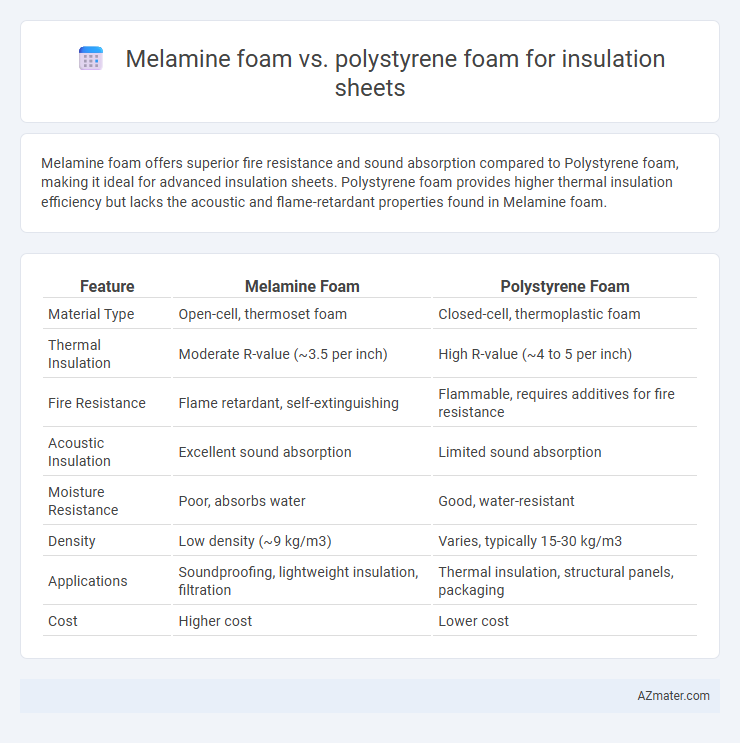Melamine foam offers superior fire resistance and sound absorption compared to Polystyrene foam, making it ideal for advanced insulation sheets. Polystyrene foam provides higher thermal insulation efficiency but lacks the acoustic and flame-retardant properties found in Melamine foam.
Table of Comparison
| Feature | Melamine Foam | Polystyrene Foam |
|---|---|---|
| Material Type | Open-cell, thermoset foam | Closed-cell, thermoplastic foam |
| Thermal Insulation | Moderate R-value (~3.5 per inch) | High R-value (~4 to 5 per inch) |
| Fire Resistance | Flame retardant, self-extinguishing | Flammable, requires additives for fire resistance |
| Acoustic Insulation | Excellent sound absorption | Limited sound absorption |
| Moisture Resistance | Poor, absorbs water | Good, water-resistant |
| Density | Low density (~9 kg/m3) | Varies, typically 15-30 kg/m3 |
| Applications | Soundproofing, lightweight insulation, filtration | Thermal insulation, structural panels, packaging |
| Cost | Higher cost | Lower cost |
Introduction to Foam Insulation Sheets
Melamine foam and polystyrene foam are widely used materials in insulation sheets, each offering distinct thermal and acoustic properties. Melamine foam is known for its open-cell structure, providing excellent sound absorption and fire resistance, making it ideal for acoustic insulation and flame-retardant applications. Polystyrene foam, particularly expanded (EPS) and extruded (XPS) types, delivers superior thermal insulation with low moisture absorption, commonly used in building walls and roofing for energy efficiency.
What is Melamine Foam?
Melamine foam is a lightweight, open-cell material known for its excellent thermal insulation and sound absorption properties, commonly used in insulation sheets. Unlike polystyrene foam, which is a closed-cell plastic with high rigidity and moisture resistance, melamine foam offers superior fire resistance and can trap air effectively to reduce heat transfer. Its structure also provides better acoustic performance, making it suitable for applications requiring both thermal insulation and noise reduction.
What is Polystyrene Foam?
Polystyrene foam is a lightweight, rigid insulation material made from expanded or extruded polystyrene beads, valued for its excellent thermal resistance and moisture resistance. Compared to melamine foam, polystyrene foam offers higher compressive strength and better structural support, making it ideal for wall, roof, and foundation insulation. Its closed-cell structure provides effective air and vapor barriers, enhancing energy efficiency in building applications.
Thermal Insulation Performance Comparison
Melamine foam offers superior thermal insulation with low thermal conductivity around 0.035 W/m*K, providing excellent heat retention and fire resistance compared to polystyrene foam, which typically has a thermal conductivity between 0.03 and 0.04 W/m*K but is less effective at high temperatures. Polystyrene foam, including expanded (EPS) and extruded (XPS) variants, provides good insulation in standard conditions but suffers from reduced performance under prolonged heat exposure and lower fire resistance. Melamine foam's open-cell structure also allows for enhanced breathability and sound absorption, making it more versatile for insulation sheets in applications requiring both thermal and acoustic control.
Fire Resistance and Safety Features
Melamine foam offers superior fire resistance compared to polystyrene foam, as it is inherently flame retardant and self-extinguishing, reducing the risk of fire propagation in insulation applications. Polystyrene foam, while effective for thermal insulation, is highly flammable and can release toxic gases when burned, posing significant safety hazards. Choosing melamine foam enhances building safety by providing both effective insulation and improved fire protection performance.
Moisture and Mold Resistance
Melamine foam offers superior moisture resistance compared to polystyrene foam, making it less prone to water absorption and maintaining its insulating properties in humid environments. Its open-cell structure allows for better vapor permeability, reducing the risk of mold growth, whereas polystyrene foam is more susceptible to moisture retention that can encourage mold development. For insulation sheets in damp or moisture-prone areas, melamine foam provides enhanced durability and mold resistance, supporting long-term performance.
Durability and Longevity
Melamine foam offers superior durability and longevity compared to polystyrene foam due to its open-cell structure, which resists compression and maintains shape over time. Polystyrene foam, particularly expanded polystyrene (EPS), is more prone to cracking and degradation when exposed to UV light and moisture, reducing its effective lifespan for insulation purposes. Melamine foam's thermal and acoustic insulation properties remain stable over years, making it a more reliable choice for long-term applications.
Environmental Impact and Sustainability
Melamine foam offers superior environmental benefits compared to polystyrene foam due to its greater biodegradability and lower carbon footprint during production. Polystyrene foam poses significant sustainability challenges as it is non-biodegradable and often contributes to long-term landfill waste and microplastic pollution. Choosing melamine foam for insulation sheets supports eco-friendly building practices and reduces overall environmental impact.
Cost Comparison of Melamine vs Polystyrene
Melamine foam typically costs more per cubic meter than polystyrene foam due to its superior fire resistance and sound absorption properties. Polystyrene foam, both EPS and XPS variants, offers a more budget-friendly option for general insulation needs, with prices significantly lower than melamine foam. When balancing cost against performance, polystyrene remains the preferred choice for large-scale insulating projects requiring cost efficiency.
Choosing the Right Foam for Your Insulation Needs
Melamine foam offers superior fire resistance and sound absorption, making it ideal for environments requiring enhanced safety and acoustic control. Polystyrene foam provides excellent thermal insulation with a higher R-value per inch, suitable for applications demanding efficient heat retention and moisture resistance. Selecting the right foam depends on prioritizing fire safety and noise reduction with melamine, or cost-effective thermal insulation and moisture barrier properties with polystyrene.

Infographic: Melamine foam vs Polystyrene foam for Insulation sheet
 azmater.com
azmater.com